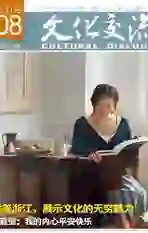千岛湖:从生态鱼到文化鱼
2018-08-06刘健
刘健
夜幕降临,华灯初上,如果你来浙江的千岛湖旅游,就一定会发现一个有趣的现象:遍布大街小巷的餐馆,到处闪烁着“千岛湖有机鱼”“生态鱼”等字眼。
千岛湖,无处不“鱼”。短短20年间,千岛湖鱼从不知名的生态鱼,跃过了道道“龙门”,转型为融入旅游的文化鱼。最新统计数据显示,这条鱼撬动的产业经济已超过人民币20亿元。
昔日千岛湖鱼是廉价货
关于传统渔业,淳安有一个传说。相传元末农民起义爆发后,渔民出生的陈友谅起兵,后与朱元璋展开了3年多的战争,大败于鄱阳湖之战。陈友谅被打败后,他手下九员大将“陈、钱、林、李、袁、孙、叶、许、何”的家族被朱元璋贬到新安江,世代以捕鱼为业,不得穿鞋,不得在岸上建房居住,更不能与岸上人通婚,形成了一个特殊的水上渔民部落,故称“九姓渔民”。
1960年,新安江水库蓄水后,“九姓渔民”后代的命运发生了根本改变,适逢淳安县成立捕捞大队,一些有经验的渔民顺理成章成为渔业工人。1962年,“淳安县新安江开发总公司”正式成立,确立“以渔为主,多种经营”的发展方针,开始了艰苦的创业历程,试图探索出一条生态渔业发展之路。
很多淳安人至今还记得上世纪七八十年代千岛湖渔业的发展盛况。“在统购统销的年代,从来没有为卖鱼而发过愁。鱼捕上来后,一般直接冷冻,然后由县里的水产供销公司根据上级业务部门的计划,用车运往杭州肉联厂,通过火车运往各地水产供销部门。”经历过那段岁月的新安江开发总公司员工汪敏说,当时千岛湖的冻鱼很受欢迎,尤其是在东北,这些鱼在农贸市场一亮相,客户就蜂拥而来。
但那个时候,千岛湖鱼的价格非常便宜,大个儿的鳙鱼不到3元一斤,鲢鱼1元多一斤,鱼头8分钱一斤,几乎是当处理品卖的。“上世纪90年代后期,由于体制及外部市场环境的变化,风光一时的千岛湖鱼开始走下坡路。”见证这场变迁的新安江开发总公司邵建强说,更糟糕的是,此时的千岛湖鱼害严重,鲢鳙鱼被肉食性鳡鱼大量摄食,产量急剧下降。为了有效保护渔业资源,千岛湖还实行三年封库禁渔,公司在渔业生产上几乎只有投入没有产出。
1998年,负债累累的淳安县新安江开发总公司引入中国林业集团,共同组建了全新的杭州千岛湖发展集团有限公司,调来懂市场的淳安县农业局局长汪建敏担任总经理。“那时候,全公司的营业额不到2000万元,亏损800万元,员工人心涣散。”汪建敏说。
在困境逼迫下,汪建敏发起了一场长达十年的“淳”鱼品牌创建工作。
品牌让鱼价猛涨数倍
步入2000年,市场发生了新变化,过去满足于冻鱼的人们,开始对活鱼感兴趣。为此,杭州千岛湖发展集团有限公司制定了年产10万斤活鱼的目标,迈出了拯救渔业的第一步。“这不仅是生产环节的一个改善,更是整条生产销售流程的变化。”汪建敏介绍说,比如为了在捕捞时不对鱼产生损伤,工人们发明了一种新式武器——沉浮式活水运渔船,通过鱼舱、艏艉浮力调节舱控制进排水的结构,使得起网后鱼能径直游到船舱里。
生产环节的改善,并非是一蹴而就,而是经过反复的琢磨和试验,包括最早的“拦、赶、刺、张”捕鱼法,颠覆了传统渔业的作业方式,彻底向精细化转型。在另一个重要环节“活鱼运输”中,公司也是交了不少“学费”。负责配送的老员工朱军介绍说,在高速公路网没有成形的年代,一旦运鱼车半路出现故障,新的运鱼车就会星夜赶往接应替换,每隔一段时间,运输人员还要关注水质、水温、含氧量、PH值等数据。
通过优化捕捞方式和改造运输流程,第二年,公司就完成了90万斤的活鱼捕捞任务。时至今日,活鱼捕捞量已占捕捞总量的99%以上。如果说从卖冻鱼到卖活鱼是一次价值的飞跃,那么品牌化战略则让千岛湖鱼的附加值实现了质的提升。2000年,杭州千岛湖发展集团有限公司注册“淳”牌商标,“淳安”的“淳”,代表着原生、原味、原鲜;之后,又把“千岛湖”作为原产地通过了国家地理标志产品的认证。
有了商标,不代表消费者就会买单,还必须导入最核心的品牌内涵。当时,在国内没有先例的情况下,杭州千岛湖发展集团有限公司向国家环保总局有机食品认证中心申请活鱼有机认证。“虽然千岛湖的生态基础好,但有机认证流程非常严格,从对环境的监测到对养殖的要求,从对饵料的把控到对疾病的防治,从捕捞到产品的运输,甚至包括宰杀等环节,都需经过认证部门严格考核。”汪建敏说,经过一年多努力,2000年10月,千岛湖鲢、鳙鱼等十多个品种的鱼类获得有机食品认证;三年后,淳安又被国家农业部命名为全国第一个“中国有机鱼之乡”。
俗话说“早起的鸟儿有虫吃”,2002年起,杭州千岛湖发展集团有限公司打响了一场全员营销战。当年5月9日,公司在杭州成功举办千岛湖淳牌有机鱼新闻发布会,邀请几十家宾馆、饭店和新闻媒体参加,淳牌有机鱼在杭州一炮打响,有机鱼的销售价格猛涨数倍。
尝到甜头后,公司启动了一连串的创意营销组合拳,在營销手段上不断创新,比如联合中国烹饪协会,承办“2002千岛湖杯全国淡水鱼烹饪大赛”,积极参加北上广举办的农博会,邀请中央电视台等媒体跟踪采访。
打造完整渔业产业链
步入21世纪,淳安开始提出旅游转型的目标。在这样的大背景下,经历品牌渔业的发展阶段后,杭州千岛湖发展集团有限公司将目光聚焦在文化创意产业上,以文化改造现有渔业产业体系,大力发展淳鱼艺术品产业、淳鱼文化休闲旅游业。
首先,大家想到的是将巨网捕鱼开发成一个旅游项目。作为渔业捕捞生产的最后一个环节,巨网捕鱼一直有着很强的观赏性:随着“嘿唑……嘿唑……”的号子声,一张一百多米的张网在20多位汉子的合力使劲下,从三个方向收拢,数万斤鲢鱼、鳙鱼受到惊吓,争相跳出水面,溅起一片片浪花。“2006年,公司投资百万元打造了全新的观光平台,专门制定了标准化操作流程,使得巨网捕鱼正式成为独立的表演项目,全年组织演出百余场,接待游客超十万人次。”捕捞一队队长叶志清说。
也就在同一年,一次偶然的機会,管理层与日本、韩国等渔业同行开展业务交流时,无意中听到了“鱼拓”这一新鲜事物——将鱼的形象用墨汁或颜料拓印在纸张上。2009年,淳安千岛湖鱼文化协会成立,同步创办国内首个鱼拓社,打造鱼拓艺术展。“任何一种艺术形式,背后的核心要素都是人,我们想到了引进人才。”汪建敏说,除了邀请韩日的鱼拓大师外,公司将目光投向国内,四处搜寻那些技艺精湛但却鲜为人知的鱼拓高手,请来了西安的年轻艺术家杨阿永,由他担当千岛湖鱼拓社社长,一有稀罕的鱼便邀请他创作。
2008年5月的一天,捕捞队在千岛湖捕获了一条151斤重的大青鱼,将它拓成了鱼拓,制作成标本,展示于千岛湖鱼博馆。千发集团联合杨阿永,用三年时间制作了《千岛湖锦鳞图》。为了将这幅巨制的传播效应发挥到极致,公司专门申报了吉尼斯世界纪录。如同最初的巨网捕鱼一样,鱼拓艺术如同水面上的涟漪渐渐散开来,鱼拓艺术品在各个节日活动上频频亮相,单幅价格低则几千,高则数万,并延伸到服装、明信片等方面,甚至还多次被淳安作为礼品运送到加拿大、澳大利亚等国的友好省市。
为了全面展示淳鱼文化,2015年,省内首家专业鱼文化博物馆“千岛湖鱼博馆”正式成立。馆内不仅有千岛湖全部114种鱼类标本,还可体验九姓渔民的生活场景和捕鱼工具;既可以欣赏法国鱼头艺术家展出的鱼头人艺术,又可现场亲手参与制作一幅鱼拓作品。此外,公司还投入巨资,建立全国第一家休闲渔业公园,融吃鱼、赏鱼、钓鱼、购鱼于一体;与鳌山村合作,以鱼文化为依托,打造鱼市一条街和主题民宿,一个有情调的鳌山渔村正在形成。
经过多年精心打造,以鱼为主题,千岛湖渔业已开发出包括巨网捕鱼、休闲垂钓、放鱼节庆、鱼文化餐饮、鱼文化景点、鱼文化工艺品等一系列新型服务业态,实现了从传统渔业、品牌渔业到文化渔业的升级转型,打造了一条完整的渔业产业链。
当下,杭州千岛湖发展集团有限公司正在考察全国各地的知名湖泊,千岛湖鱼的成功模式或将遍地开花。
No sane traveler would leave Qiandaohu, a popular tourist destination in Chunan County, Zhejiang Province, without trying the “spicy fish head”, a local signature delicacy that has become a calling card of Qiandaohu Town. Statistics indicate that “fish” has generated an annual income of two billion yuan into the local economy.
The towns fame is closely associated with the namesake lake. Qiandaohu Town is just a dot by the 567-km2 lake called Qiandaohu, or 1,000-isle Lake, a reservoir made in 1960.
About the fishing tradition of Qiandaohu, legend has it that Chen Youliang, a local fisherman, kept fighting against Zhu Yuanzhang (the first emperor of the Ming Dynasty 1368-1644) in the last three years of the Yuan Dynasty (1279-1368). After losing the fierce and grueling fight, the nine core groups of the soldiers of Chens army were banished to todays Xinan River and were banned from wearing shoes or living onshore. They are believed to have been the ancestors of the towns “gypsies”, or “nine-surname fishing people”, who traditionally lived on junks and fished as their traditional livelihood, like the Tankas in the south. Historically, they were considered to be outcasts. The descendents of these boat people have preserved many of their ancestors traditions although nowadays most dont live in boats on the river.
The life of the “boat people” on Xinan River began changing drastically in 1960, when the Xinan Reservoir went operational. The more experienced fishing people joined the countys fishing team to make a living. The 1970s and 1980s saw the heyday of the fishing industry of Qiandaohu. “We never had to worry about sales in a market in which everything else was planned and managed by the government. All we needed to do was to send the hauls of the day for quick freezing and transport them to the Hangzhou Meat Processing Factory and other supply and marketing cooperatives,” Wang Min recalled. “The frozen fish from Qiandaohu enjoyed a dedicated following in northeastern parts of the country.”
The decline of the fishing industry of Qiandaohu came in the late 1990s, when the market reshuffle came and the worsening of water ecology added insult to injury. The yield of “Qiandaohu fish” took a nosedive and resulted in a three-year fishing ban imposed to restore fish resources.
The new consumption trend came around in the year 2000. Frozen fish fell into disfavor. Gourmets became interested in eating fish fresh from water. Sensing the new opportunity, Hangzhou Qiandaohu Development Group set new goals to salvage the languishing fishing industry of the county. “The result was not only improvements on production but a brand-new industrial chain, with new tools invented and fishing efficiency greatly improved,” recalled Wang Jianmin, a government official with the countys agricultural authorities. Technological innovation brought in a total yield of 450,000kg of live fish in 2001.
In addition to the sharp increase of catch, the company did a series of things to improve its market competitiveness. In 2000, it launched its new trademark “Chun”, which indicates the geographical roots of “Qiandaohu fish” as well as the unique quality of the fish from Qiandaohu. This was an important step taken by the company in its “organic reform”. In October 2000, a dozen kinds of fish from Qiandaohu were granted the Organic Food Certification. In 2003, Chunan became Chinas first “capital of organic fish” in China.
Today, the countys brisk organic fish industry does more than just satisfying the taste buds of gourmets. People go to Qiandaohu for more reasons than sightseeing and trying the countys signature hot and spicy “fish head”.
A new goal of the Qiandaohu Development Group is to weave the local fishing tradition into tourism and creative industry. In 2006, the company launched a new “giant-net fishing” product tailor-made for tourists to feast the eye on the spectacle that illustrates the countys fishing glory in a “seeing is believing” way. Giant-net fishing is a spectacular must for many tourists. It has been broadcast on television for years.
In 2009, the company unveiled Qiandaohu Fish Culture Association and Chinas first Society. Gyotaku is an art that prints fish onto paper that originated in Japan and has evolved with different approaches. It dates back to the mid-1800s. This form of nature printing was used by fishermen to record their catches, but has also become an art form of its own. Over the years, the Association has worked with Japanese artists and Yang Ayong, a young artist from Xian. One of the clubs master works is created from a black carp that weighed more than 75kg. The artworks from local artists add a strong cultural touch to Qiandaohu.
